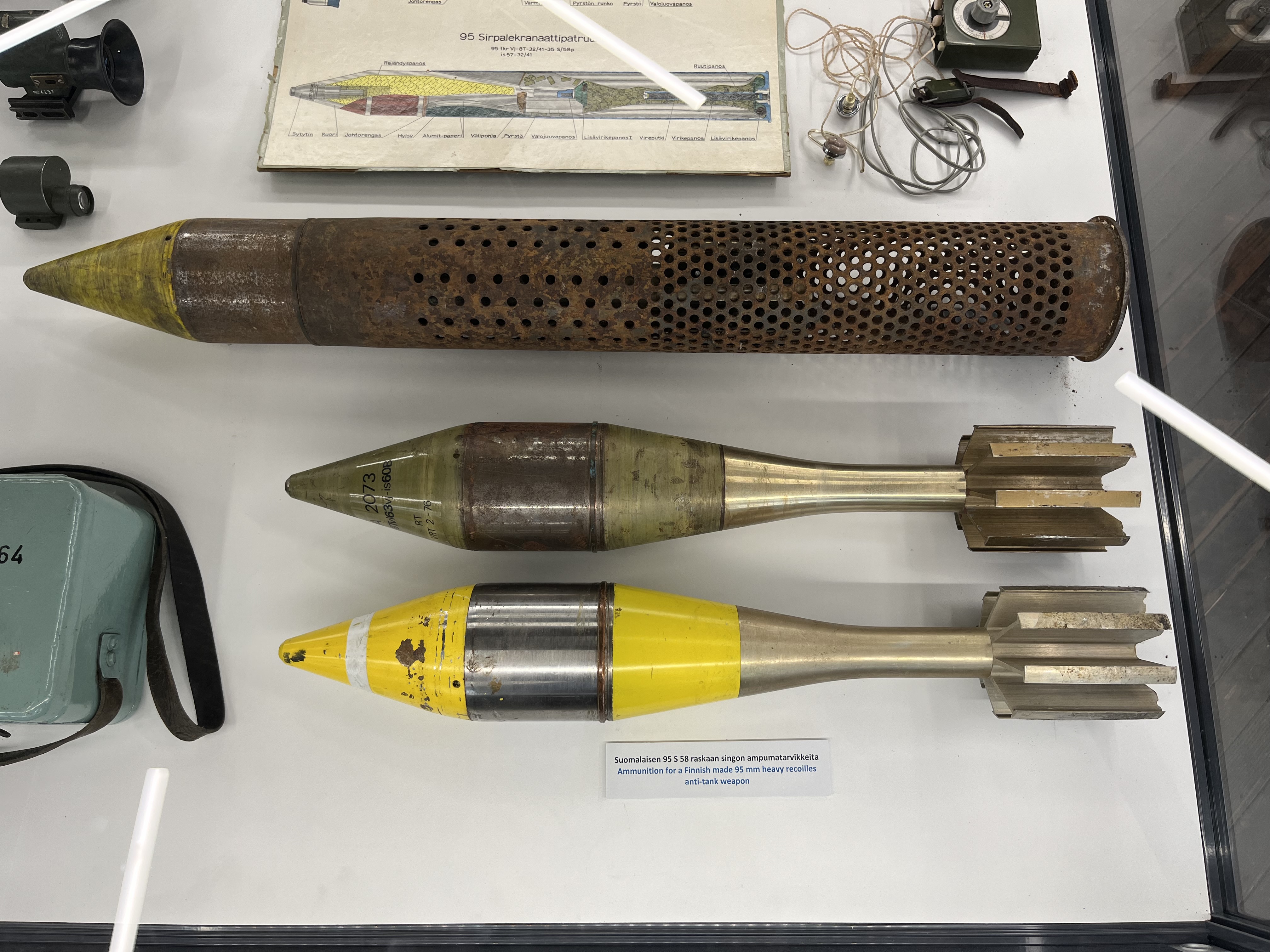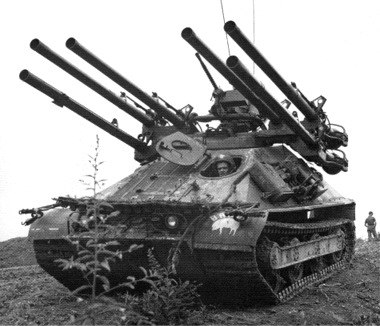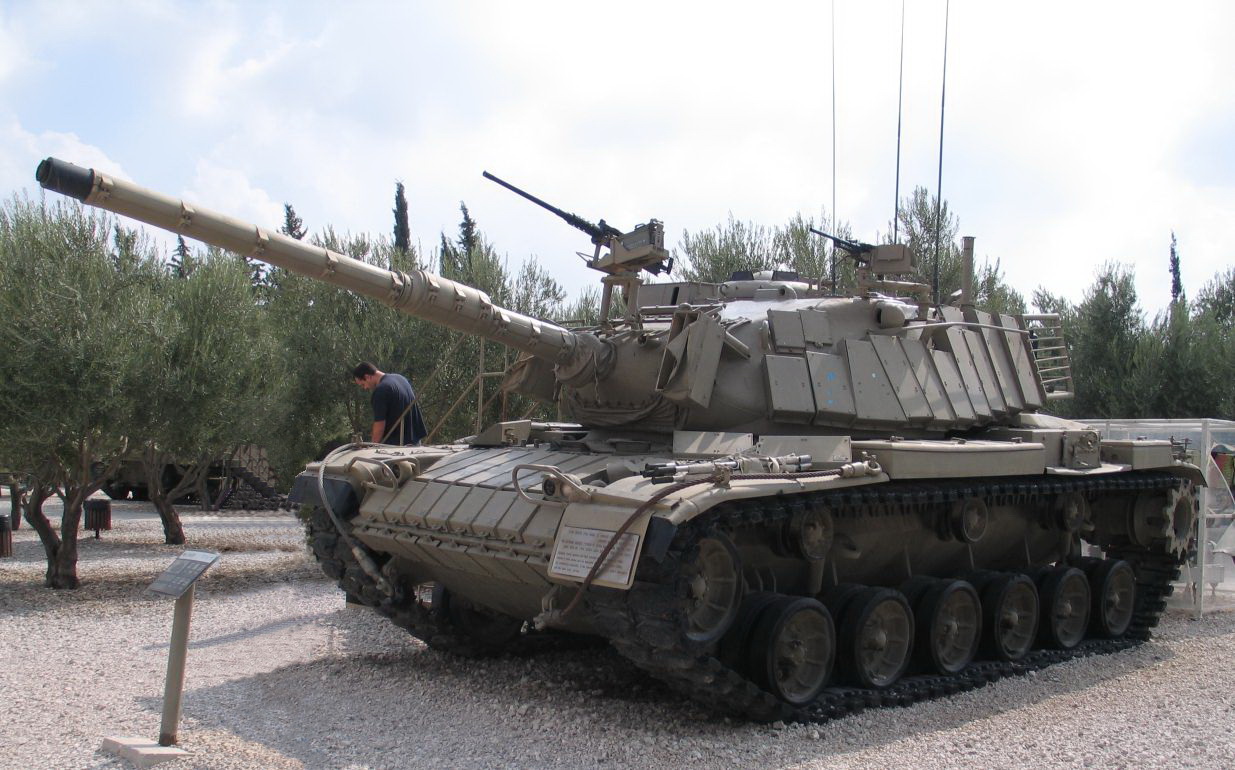|
95 S 58-61
The 95 S 58-61 is a heavy recoilless anti-tank weapon used by the Finnish Army. It is also referred to as ''raskas sinko'' (''heavy recoilless rifle''), or colloquially as ''Musti'' ("Blackie"). The weapon was developed in 1958 and it was given a new wheel-equipped carriage in 1961. The name of the weapon means "95 mm, Sinko, model 1958/1961", where ''sinko'' is the Finnish word for recoilless weapon. The weight of the weapon system is 140 kg and its caliber is 95 mm (3.75 inches). Its effective range is 700 m against moving targets and 1,000 m against positioned targets. It can penetrate about 550 mm steel. Its HEAT ammunition is equipped with a strengthened nose section to better its effectiveness against explosive reactive armour (ERA). The weapon team consists of 8 men: leader, shooter, loader/reserve shooter and two ammunitions handlers plus the reserve leader and two extra men armed with M72 LAWs and APILAS (currently being replaced by the 102 RSLPSTOH ... [...More Info...] [...Related Items...] OR: [Wikipedia] [Google] [Baidu] |
95 S 58-61 Recoilless Rifles
{{Numberdis ...
95 or 95th may refer to: * 95 (number) * one of the years 95 BC, AD 95, 1995, 2095, etc. * 95th Division (other) * 95th Regiment ** 95th Regiment of Foot (other) * 95th Squadron (other) * Atomic number 95: americium * Microsoft Office 95 * Saab 95 * Windows 95 See also * 9 to 5 (other) * * List of highways numbered A ''list'' is any set of items in a row. List or lists may also refer to: People * List (surname) Organizations * List College, an undergraduate division of the Jewish Theological Seminary of America * SC Germania List, German rugby union ... [...More Info...] [...Related Items...] OR: [Wikipedia] [Google] [Baidu] |
NLAW
The Saab Bofors Dynamics NLAW (pronounced: ''"N-LAW"'', ), also known as the MBT LAW or RB 57, is a fire-and-forget, lightweight shoulder-fired, and disposable (single-use) line of sight (LOS) missile system, designed for infantry use. The missile uses a soft-launch system and is guided by predicted line of sight (PLOS). It can carry out an overfly top attack (OTA) on an armoured vehicle, or a direct attack (DA) on structures and non-armoured vehicles. The system was developed in Sweden by prime contractor Saab Bofors Dynamics, on behalf of the British and Swedish defence authorities who procured the system in a joint venture. It was mainly produced in the United Kingdom by Team MBT LAW UK, which included 14 subcontractors, most notably Thales Air Defence. Users of the weapon include Finland, Indonesia, Luxembourg, Malaysia, Sweden, Switzerland, Ukraine, and the United Kingdom. Etymology The name "NLAW" initially referred to the original British development programme whic ... [...More Info...] [...Related Items...] OR: [Wikipedia] [Google] [Baidu] |
Anti-tank Weapons
Anti-tank warfare originated from the need to develop technology and tactics to destroy tanks during World War I. Since the Triple Entente deployed the first tanks in 1916, the German Empire developed the first anti-tank weapons. The first developed anti-tank weapon was a scaled-up bolt-action rifle, the Mauser 1918 T-Gewehr, that fired a 13mm cartridge with a solid bullet that could penetrate the thin armor of tanks of the time and destroy the engine or ricochet inside, killing occupants. Because tanks represent an enemy's strong force projection on land, military strategists have incorporated anti-tank warfare into the doctrine of nearly every combat service since. The most predominant anti-tank weapons at the start of World War II in 1939 included the tank-mounted gun, anti-tank guns and anti-tank grenades used by the infantry, and ground-attack aircraft. Anti-tank warfare evolved rapidly during World War II, leading to the inclusion of infantry-portable weapons such a ... [...More Info...] [...Related Items...] OR: [Wikipedia] [Google] [Baidu] |
Recoilless Rifles
A recoilless rifle, recoilless launcher or recoilless gun, sometimes abbreviated "RR" or "RCL" (for ReCoilLess) is a type of lightweight artillery system or man-portable launcher that is designed to eject some form of countermass such as propellant gas from the rear of the weapon at the moment of firing, creating forward thrust that counteracts most of the weapon's recoil. This allows for the elimination of much of the heavy and bulky recoil-counteracting equipment of a conventional cannon as well as a thinner-walled barrel, and thus the launch of a relatively large projectile from a platform that would not be capable of handling the weight or recoil of a conventional gun of the same size. Technically, only devices that use spin-stabilized projectiles fired from a rifled barrel are recoilless rifles, while smoothbore variants (which can be fin-stabilized or unstabilized) are recoilless guns. This distinction is often lost, and both are often called recoilless rifles. Though sim ... [...More Info...] [...Related Items...] OR: [Wikipedia] [Google] [Baidu] |
M40 Recoilless Rifle
The M40 recoilless rifle is a portable, crew-served 105 mm recoilless rifle made in the United States. Intended primarily as an anti-tank weapon, it could also be employed in an antipersonnel role with the use of an antipersonnel-tracer flechette round. The bore was commonly described as being 106 mm caliber but is in fact 105 mm; the 106 mm designation was intended to prevent confusion with incompatible 105 mm ammunition from the failed M27. The air-cooled, breech-loaded, single-shot rifle fired fixed ammunition and was used primarily from a wheeled ground mount. It was designed for direct firing only, and sighting equipment for this purpose was furnished with each weapon, including an affixed spotting rifle. A limited number of M50 Ontos were built as a self-propelled light armored tracked anti-tank vehicle. They had six 106 mm M40 recoilless rifles as its main armament, which could be fired in rapid succession against a single target to guarantee ... [...More Info...] [...Related Items...] OR: [Wikipedia] [Google] [Baidu] |
55 S 55
55 S 55 (from Finnish , '55 millimetre recoilless anti-tank weapon model 1955'), colloquially ''kevyt sinko'' and nicknamed Nyrkki, was a Finnish recoilless anti-tank weapon from the mid-1950s. The 55 S 55 was designed by a Finnish Defence Forces team led by MSc, Capt Esko Puronto, and it was manufactured by FDF's Vammaskoski factory (now part of Finnish state military industrial enterprise Patria). History During the later stages of World War II, Finland received large shipments of German Panzerfaust (F1 and F2) and Panzerschreck. These weapons were used after the war, but soon the need for modern replacement arose. After the World War II, short-range anti-tank weaponry was seen as the most important anti-tank weaponry by the Finnish Defence Forces, and it was seen that the further the short-range weaponry could be developed, the less there would be need for the more expensive long-range weaponry. Finland's forested areas were seen as optimal terrain for light, highly portable an ... [...More Info...] [...Related Items...] OR: [Wikipedia] [Google] [Baidu] |
Finnish Defense Forces
The Finnish Defence Forces ( fi, Puolustusvoimat, sv, Försvarsmakten) are the military of Finland. The Finnish Defence Forces consist of the Finnish Army, the Finnish Navy and the Finnish Air Force. In wartime the Finnish Border Guard (which is its own military unit in peacetime) becomes part of the Finnish Defence Forces. Universal male conscription is in place, under which all men serve for 165, 255, or 347 days, from the year they turn 18 until the year they turn 29. Alternative non-military service for men and voluntary service for women is available. Finland is the only non-NATO European Union state bordering Russia. Finland's official policy states that a wartime military strength of 280,000 personnel constitutes a sufficient deterrent. The army consists of a highly mobile field army backed up by local defence units. The army defends the national territory and its military strategy employs the use of the heavily forested terrain and numerous lakes to wear down an aggr ... [...More Info...] [...Related Items...] OR: [Wikipedia] [Google] [Baidu] |
Finnish Language
Finnish ( endonym: or ) is a Uralic language of the Finnic branch, spoken by the majority of the population in Finland and by ethnic Finns outside of Finland. Finnish is one of the two official languages of Finland (the other being Swedish). In Sweden, both Finnish and Meänkieli (which has significant mutual intelligibility with Finnish) are official minority languages. The Kven language, which like Meänkieli is mutually intelligible with Finnish, is spoken in the Norwegian county Troms og Finnmark by a minority group of Finnish descent. Finnish is typologically agglutinative and uses almost exclusively suffixal affixation. Nouns, adjectives, pronouns, numerals and verbs are inflected depending on their role in the sentence. Sentences are normally formed with subject–verb–object word order, although the extensive use of inflection allows them to be ordered differently. Word order variations are often reserved for differences in information structure. Finnish orth ... [...More Info...] [...Related Items...] OR: [Wikipedia] [Google] [Baidu] |
APILAS
The RAC 112 APILAS (Armor-Piercing Infantry Light Arm System) is a portable one-shot 112 mm recoilless anti-tank weapon, designed in France by GIAT Industries. Over 120,000 of the APILAS launchers have been produced, and they are in service with many countries. Description The APILAS is supplied in an aramid fibre launcher tube with a retractable sight. The effective range of APILAS is from 25 m (it takes 25 m for the rocket to arm itself) up to 300-500 m depending on the target. The shaped charge warhead is electrically fused and will detonate at impact angles up to 80 degrees. Although heavy, the APILAS is able to pierce 700 mm of RHA. Within the French Army it is categorized as "traumatic weapon", because of its blast and noise. A French soldier cannot fire it more than three times in his service during peacetime. An off-route mine system was developed using the APILAS rocket mounted on a tripod using a sensor package, or tripwires. Production 84,000 were ordere ... [...More Info...] [...Related Items...] OR: [Wikipedia] [Google] [Baidu] |
Moving Heavy Recoilless Rifle In Sodankylä Jun1997
Moving or Movin' may refer to: Moving of goods * Relocation (personal), the process of leaving one dwelling and settling in another * Relocation of professional sports teams * Relocation (computer science) * Structure relocation Music Albums * ''Moving'' (Peter, Paul and Mary album), 1963 * ''Moving'' (The Raincoats album), 1983 * ''Movin (Herman van Doorn album), 2001 * ''Movin (Jennifer Rush album), 1985 Songs * "Moving" (Kate Bush song), 1978 * "Moving" (Supergrass song), 1999 * "Moving" (Travis song), 2013 * "Moving", by Suede from '' Suede'', 1993 * "Moving", by Cathy Davey from '' Tales of Silversleeve'', 2007 * "Movin (Brass Construction song), 1976 * "Movin (Mohombi song), 2014 * "Movin, by Skin from ''Fake Chemical State'', 2006 Other uses * ''Moving'' (1988 film), a comedy starring Richard Pryor * ''Moving'' (1993 film), a Japanese film * ''Moving'' (British TV series), a British sitcom starring Penelope Keith * Moving (South Korean TV series), ... [...More Info...] [...Related Items...] OR: [Wikipedia] [Google] [Baidu] |
M72 LAW
The M72 LAW (light anti-tank weapon, also referred to as the light anti-armor weapon or LAW as well as LAWS: light anti-armor weapons system) is a portable one-shot unguided anti-tank weapon. The solid rocket propulsion unit was developed in the newly-formed Rohm and Haas research laboratory at Redstone Arsenal in 1959, and the full system was designed by Paul V. Choate, Charles B. Weeks, Frank A. Spinale, et al. at the Hesse-Eastern Division of Norris Thermadore. American production of the weapon began by Hesse-Eastern in 1963, and was terminated by 1983; currently it is produced by Nammo Raufoss AS in Norway and their subsidiary, Nammo Talley, Inc. in Arizona. In early 1963, the M72 LAW was adopted by the U.S. Army and U.S. Marine Corps as their primary individual infantry anti-tank weapon, replacing the M31 HEAT rifle grenade and the M20A1 "super bazooka" in the U.S. Army. It was subsequently adopted by the U.S. Air Force to serve in an anti-emplacement and anti-armor rol ... [...More Info...] [...Related Items...] OR: [Wikipedia] [Google] [Baidu] |
Explosive Reactive Armour
Reactive armour is a type of vehicle armour that reacts in some way to the impact of a weapon to reduce the damage done to the vehicle being protected. It is most effective in protecting against shaped charges and specially hardened kinetic energy penetrators. The most common type is ''explosive reactive armour'' (ERA), but variants include ''self-limiting explosive reactive armour'' (SLERA), ''non-energetic reactive armour'' (NERA), ''non-explosive reactive armour'' (NxRA), and electric armour. NERA and NxRA modules can withstand multiple hits, unlike ERA and SLERA. A second hit in exactly the same location may potentially penetrate any of those, as the armour in that spot is compromised. Reactive armour is intended to counteract anti-tank munitions that work by piercing the armour and then either kill the crew inside, disable vital mechanical systems, or create spalling that disables the crew — or all three. Reactive armour can be defeated with multiple hits in the same pla ... [...More Info...] [...Related Items...] OR: [Wikipedia] [Google] [Baidu] |









